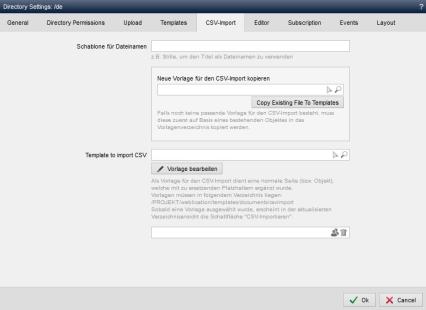Directory settings - CSV import
You can use the 'CSV import' tab to create pages / objects based on a CSV file. Importing data from a database or Excel table into objects in Weblication® is significantly simplified by the CSV import wizard.
In this way, for example, current messages, event dates, store product pages and much more can be created from the underlying CSV file. If a template is available, a "Import CSV" button is offered in the corresponding directory in the directory bar.

Operation
'Template for file name':
In this field, you can optionally enter the value for the file name to be used for each object. With a leading dollar sign, you can refer to the column names (first line of the CSV file).
Example:
Lastname;Firstname;Street;City
The template looks like this if you want the file names to be generated with lastname-firstname.php:
$surname-$firstname
If nothing is specified in the field, the files are numbered consecutively(1.php, 2.php, etc.).
In addition to the specification for column names (e.g. $surname), the following general placeholders are also possible:
- $year
- $month
- $day
- $hour
- $minute
- $second
- $margin
As of CMS version 018.007.009.000, the files to be created can also be written in lower case (e.g. toLower($title) ).
'Copy new template for CSV import':
In this field, an object page can be selected via the file selection in order to copy it to the templates of the CSV import. This can be, for example, an existing object of a current notification, a store product or similar.
As soon as an existing file path is stored in the field, this file can be stored as a template for the CSV import by clicking on the"Copy existing object to templates" button.
'Template for CSV import':
In this field, you store the file path of the template that is to be used for the CSV import. If the field is empty, the file selection starts in the general csvimport directory.
Click on the"Edit template" button to open the template for the CSV import.
'User group that is allowed to import':
In this field, you can optionally store a user group using the button for group selection. Only users who are members of this group will then be able to import CSVs for this directory.


